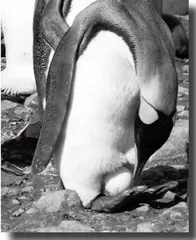There Is No Time Left for Antarctica’s Emperor Penguins 南极帝企鹅已危在旦夕

For emperor penguins, sea ice is essential to survival. The iconic birds, found only in Antarctica, breed, lay their eggs, and raise their chicks on fast sea ice (meaning it is attached to land). They arrive at their breeding sites in late March. In May and June, they lay their eggs, which hatch after 65 days during the cold Antarctic winter. The chicks then remain on the ice until their fluffy down is replaced by waterproof feathers. In addition, they also rely on stable sea ice for protection from predators.
就帝企鹅来说,海冰的存在对于生存至关重要。这种标志性鸟类只见于南极洲,它们在坚硬的海冰上(意味着它附着在陆地上)繁殖、产卵和养育幼崽。它们于每年3月下旬抵达繁殖地。5月和6月,它们产卵,卵在65天后,即在南极严酷的冬季孵出。然后,雏鸟会留在冰面上,直到它们蓬松的绒毛退化,长出防水的羽毛。此外,它们还依靠稳固的海冰来免受捕食者的侵害。
In 2022, sea ice levels in Antarctica were at an all-time low. The Bellingshausen Sea region, to the west of the Antarctic Peninsula, saw the most serious reduction of sea ice, with some areas experiencing a 100-percent loss.
Of the five known emperor penguin groups in the Bellingshausen Sea region, all but one experienced what was most likely a total breeding failure because of the loss of sea ice, according to a paper published in Communications Earth & Environment. Satellite imagery clearly showed the sea ice had broken up before the chicks would have developed enough to survive on their own.
2022年,南极洲的海冰高度创下历史新低。位于南极半岛西部的别林斯高晋海地区的海冰减少最为严重,部分地区的海冰已不复存在。
据《通讯·地球与环境》上的一篇文章介绍,在别林斯高晋海地区已知的五个帝企鹅群中,只有一个帝企鹅群没有遇到由于海冰消失让繁殖很可能彻底失败的情况。卫星图像清楚地显示,在雏鸟发育到足以独立生存之前,海冰就已经破裂了。
“We have never seen emperor penguins fail to breed at this scale in a single season,” the study’s lead author, Peter Fretwell of the British Antarctic Survey, said in a statement. “The loss of sea ice in this region during the Antarctic summer made it very unlikely that displaced chicks would survive.”
The study team also estimate their findings support a projection that, if present warming rates continue, more than 80 percent of emperor penguin groups will be nearly extinct by 2100. The recent breeding failures “could be a snapshot of what happens in a future Antarctica,” says Norman Ratcliffe of the British Antarctic Survey, a co-author of the new study.
The biggest threat to emperor penguins is undoubtedly climate change. As the world warms, sea ice will decline and emperor penguins—as well as other animals—will likely follow suit. Jeremy Wilkinson, a sea ice physicist also at the British Antarctic Survey, stated that the breeding failure “dramatically reveals the connection between sea ice loss and ecosystem destruction”.
For species such as the emperor penguin, the crisis is already underway. “There is no time left,” Wilkinson says.
该文章的主要作者、英国南极调查局的彼得·弗雷特韦尔在一份声明中表示:“我们从未见过帝企鹅在一个繁殖季如此大规模地繁殖失败。在南极的夏季,该地区消失的海冰使得流离失所的小企鹅很难生存。”
研究小组还预测:如果以目前的变暖速度持续下去,到 2100年,超过80%的帝企鹅群落将濒临灭绝。这项新研究的合著者、英国南极调查局的诺曼·拉特克利夫说,近来的繁殖失败“可能是南极洲未来状况的缩影”。
帝企鹅面临的最大威胁无疑是气候变化。随着地球变暖,海冰将会减少,帝企鹅以及其他动物可能也会减少。英国南极调查局的海冰物理学家杰里米·威尔金森表示,这次繁殖失败“让海冰消失与生态系统破坏之间的关联昭然若揭”。
对于帝企鹅等物种来说,危机已经到来。“没有时间了。”威尔金森说。